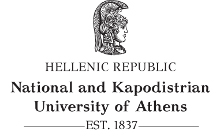Menu
- NEWS AND EVENTS
- THE PROGRAM
- ADMISSION
- MODULES
-
ACADEMIC STAFF
- IOANNIS ALEXOPOULOS
- ANTHI BALITSARI
- GIORGOS BOUROGIANNIS
- ANASTASIA DRANDAKI
- DIMITRIS FILIOGLOU
- ATHANASIOS GODELITSAS
- DIMITRIS GRIGOROPOULOS
- MYRSINI GOUMA
- PANAGIOTIS KARKANAS
- ΕURYDICE KEFALIDOU
- KONSTANTINOS KOPANIAS
- KATERINA KOULI
- GEORGE LYRAS
- IFIGENEIA MEGREMI
- DIMITRIS MICHAILIDIS
- ARTEMIOS OIKONOMOU
- YIANNIS PAPADATOS
- KATERINA PAPAYIANNI
- VASSILIS PETRAKIS
- PLATON PETRIDIS
- PANAGIOTIS POMONIS
- MICHEL ROGGENBUCKE
- DIMITRIS ROUSSOS
- ELISABETH STATHOPOULOU
- GEORGIA TSARTSIDOU
- KYRIAKI TSIRTSI
- NIKOLAOS VOULGARIS
- PROGRAM REGULATIONS
-
ACADEMIC FACILITIES
- LABORATORY OF ARCHAEOLOGY
- LABORATORY OF MINERALOGY AND PETROLOGY
- LABORATORY OF HISTORICAL GEOLOGY AND PALAEONTOLOGY
- LABORATORY OF GEOPHYSICS
- CORE FACILITY OF THE SCHOOL OF SCIENCE
- MUSEUM OF ARCHAEOLOGY AND ΗISTORY OF ART
- MUSEUM OF MINERALOGY AND PETROLOGY
- MUSEUM OF GEOLOGY AND PALAEONTOLOGY
- LIBRARY OF THE SCHOOL OF PHILOSOPHY
- LIBRARY OF THE SCHOOL OF SCIENCE
- WIENER LABORATORY
- STUDENTS
- RESEARCH
- CONTACT US
